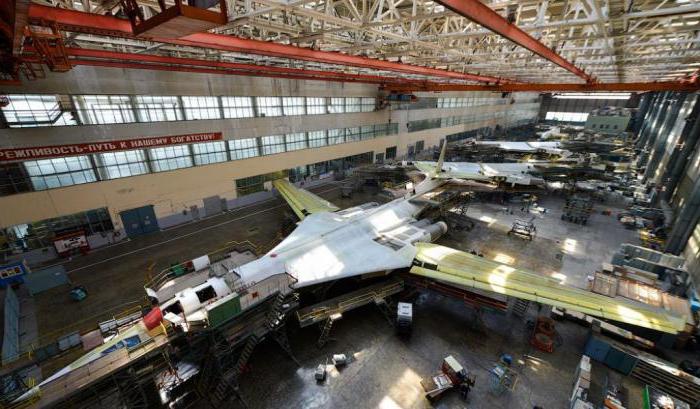Gorbunov Kazan Aircraft Plant is a leading Russian aviation company specializing in the assembly of strategic bombers, civilian and special-purpose aircraft. Since 2013, it has been a branch of PJSC Tupolev.
Description
OJSC Kazan Aviation Plant is located in the capital of Tatarstan - in Kazan. In addition to the main production, it is responsible for the nearby Borisoglebskoye test aerodrome. The company played an important role in the country's defense. Strategic long-range bombers were produced here, including those capable of transporting nuclear weapons.
KAZ has a high scientific and production potential. The accumulated experience allows us to take on the development of advanced projects. Within its walls, specialized liners of the highest reliability are assembled for the Office of the President of the Russian Federation, the General Staff, and intelligence agencies.
Work days
Kazan Aircraft Plant was originally created as a branch of the Moscow Aircraft Plant. The laying of the first workshop began in 1932, by 1935 the main structures were erected. In parallel, a motor plant was being built, the Social Town housing estate. However, the rolling repression led to a personnel leapfrog, and the real release of aircraft was possible to organize only in 1938.
The initial plans were grandiose - to assemble the sky giants ANT-16, ANT-20 (Maxim Gorky), ANT-26 (with a 16-ton bomb load and a 95-meter wingspan). However, plans did not go further than paper. Of the three ANT-20bis heavy planes laid on the slipways in 1936, only by 1939 did they manage to assemble the first of them (with a state order of 18 units). The production experience of the Annushka DB-A bombers turned out to be unsuccessful.
For the glory of the motherland
In 1939, the Kazan Aviation Plant began the development of a new model, “Machine No. 2,” the future Pe-8 designed by Petlyakov. The distant 4-motor transport bomber became the main one in the Red Army Red Army and brought the plant a well-deserved labor victory. Pe-8 (ANT-42) became the first Soviet high-speed high-altitude aircraft of the Flying Fortress class. He possessed elegant streamlined forms as opposed to the angular “slow-moving” of previous generations.
A little later, the main model for the plant was a dive bomber of the same Pe-2 designer. During the war years KAZ assembled about 10,000 vehicles. Production worked without stops, weekends and holidays.
Plant of strategic importance
World War II showed the importance of long-range heavy bombers capable of paralyzing enemy infrastructure and production. With the development of more powerful bombs, their effectiveness has increased. In the early years of peace, the Kazan Aviation Plant produced under the Tu-4 brand a copy of the well-established American B-29 model. However, a piston aircraft with a flight range of just over 5,000 km was not continental. Namely, the USA became the main geopolitical adversary of the USSR.

The Tu-16 strategic jet aircraft, capable of acting both as a bomber and as a missile carrier, reconnaissance aircraft, tanker, etc., became a breakthrough. A speed of 980 km / h and an ascent height of up to 13,400 m made it quite easy to overcome enemy air defense lines. However, its flight range was even less than that of the Tu-4 - 4000 km. It was effective against ship formations, supplemented the firepower of the USSR Navy and coastal defense. The first serial device was manufactured at KAZ in 1953. According to statistics, the Tu-16, withdrawn from the Russian Air Force system only in the 90s, is the most long-lived aircraft in the world. Its modified counterparts continue to serve in China and several other countries.
The next step was the Tu-22 family of long-range subsonic strategic missile carriers. The basic model was produced from 1960 to 1966. A total of 311 units were collected. From 1967 to 1990, modifications were made of the Tu-22M (0-1), Tu-22M2 and Tu-22M3 with improved aerodynamics and technical specifications.
Civil Aircraft
In addition to military aircraft, the Kazan Aviation Plant produced passenger jet liners. In the early 50s, the government commissioned, based on the successful Tu-16 model, to construct an aircraft for the transport of passengers and goods. As a result, the Tu-104 was created - the first jet airliner in the USSR. In 1956, an improved modification of the Tu-110 was created for the party apparatus and secretaries-general.
In the 60s, part of the capacity was reoriented to the transport and passenger long-range IL-62, which was replaced by the IL-62M. Until 1994, 278 devices of both modifications were manufactured. In the mid-90s, KAZ mastered the Tu-214 model, which was certified in 1997. Now the design bureaus are working on projects of the short-range passenger Tu-324 and the transport carrier Tu-330.
"White Swan"
12/18/1981 the first flight was made by an unprecedented previously super-heavy Tu-160 bomber, referred to in NATO as “Blackjack”. Its unique form with a swept wing in flight resembles a proud graceful swan. That is why in Russia it is affectionately called the "White Swan".
Although its production was discontinued, Kazan Aviation Plant. S.P. Gorbunov from the president received an order to resume assembling the strategic bomber with improved avionics, new electronic and technical components. A range of almost 14,000 km allows you to hit targets on other continents. Tu-160s form the basis of the aviation component of the "nuclear triad" of Russia.
Products
Today, KAZ performs the following works:
- Modernization of the Tu-22M3.
- Production, maintenance of Tu-160.
- Production, maintenance of modifications Tu-214.
- Service IL-62M.
- Production of special aircraft.
- Development of new aircraft.
Kazan Aircraft Plant remains a recognized authority in the aircraft industry. The merger with PJSC Tupolev accelerates the introduction of new aircraft models and allows to unify production.